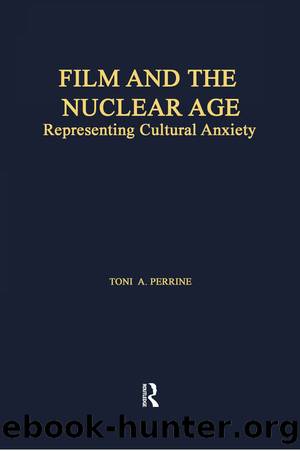Film and the Nuclear Age by Toni A. Perrine

Author:Toni A. Perrine [Perrine, Toni A.]
Language: eng
Format: epub
Tags: History, General
ISBN: 9781317732198
Google: wvODDwAAQBAJ
Publisher: Routledge
Published: 2019-01-22T17:44:17+00:00
C. Nuclear Submarines
The submarine provides an especially interesting setting in which the themes of the Cold War nuclear disaster film are played out and intensified. Itself an expression of murky phallic power, the nuclear weapons carried by the nuclear propulsion submarine are now the most important component of the U.S. nuclear triad. Conservative journalist George Will asserts, âU.S. submarines were crucial in winning three warsâthe world wars and the Cold Warâand today may be what battleships and then aircraft carriers were: the capital shipsâthose vessels that, when present, control the sea.â18 All that power packed into a 560 foot tube can play havoc with a crew that is exclusively male, rigidly hierarchical and almost continually under conditions of psychological and physical stress.
In Voyage to the Bottom of the Sea (1961), a strange atmospheric phenomenon called Van Allenâs belt (presumably the result of atmospheric testing of nuclear weapons) creates a radioactive sky that disrupts the Earthâs weather patterns, creates a âfrightening ring of fire encircling the Earth,â and threatens world destruction. A U.S. admiral concocts a plan to fire a nuclear missile in order to explode the belt clear of the Earthâs magnetic pull, but his scheme is regarded as âsuicidal insanityâ by the worldâs scientists who have gathered at the United Nations to review it. Convinced that he can save the Earth, and willing to jeopardize his crew in the quest, the admiral hijacks a nuclear submarine and encounters incredible dangers, including mine fields, attacks by other subs, and even a giant octopus, in his rush to reach the proper location for the missile shot (dictated by the earthâs rotation). This synopsis does not do justice to the bizarre intricacies of the plot, but the film ends when the belt burns itself out, the crisis is suddenly over and the sub sets full speed for home under blue skies.
Voyage to the Bottom of the Sea is probably most readily compared to On The Beach (1959, discussed in Chapter V) because it was a big Hollywood studio production with well-known stars, a serious director and a fairly ludicrous premise (the ludicrous premise being something more readily acceptable in a âB,â or low budget production). A central theme in Voyage to the Bottom of the Sea involves the question of whether to fight what seems like the inevitable end, or to accept âGodâs willâ and go meekly into the night of annihilation. Near the end of the film, Alvarez, who has continually argued for inner peace through resignation, says to the admiral: âYou have no right to challenge Godâs will. We have sown sin, now we must reap the whirlwind. Godâs will is written across the heavens.â Nuclear retribution as the expression of Godâs displeasure is usually not so baldly stated in nuclear films, although certainly present at a more subtextual level. As an expression of Cold War anxiety, Voyage to the Bottom of the Sea has it all: mysterious, unstoppable forces, discord between nations, leaders who may be deranged, and weather conditions straight out of Revelations.
Download
This site does not store any files on its server. We only index and link to content provided by other sites. Please contact the content providers to delete copyright contents if any and email us, we'll remove relevant links or contents immediately.
Naked as Nature Intended by Pamela Green(417)
The Filmmaker's Guide to Creatively Embracing Limitations: Not Getting What You Want Leading to Creating What You Need (for True Epub) by Pace William & Stobbe Ingrid(412)
30 Movies to Get You Through the Holidays by Roger Ebert(388)
Bond, James Bond by Brad Gilmore(352)
It's Only a Movie! by Haberski Jr. Raymond J(321)
Chinese films in focus II by Unknown(280)
How To Write A Novel The Easy Way Using The Pulp Fiction Method To Write Better Novels: Writing Skills by Jim Driver(269)
The Fellowship of the Knits: Lord of the Rings: The Unofficial Knitting Book by Tanis Gray(266)
Smartphone Cinema: Making Great Films with Your Mobile Phone by Bart Weiss(265)
Film Truth; November, 1920 by Anonymous(259)
Charles McGraw by Alan K. Rode(259)
The Greatest Show on Earth by Jerry Pinto(253)
Thomas Mann and Friedrich Nietzsche: Eroticism, Death, Music, and Laughter by Caroline Joan Picart(233)
The Garden in the Machine by Unknown(232)
Jafar Panahi: Interviews by Unknown(230)
The Reel Truth by Reed Martin(229)
Jurassic Park and Philosophy by Watkins Jessica Michaud Nicolas(226)
The Japanese Cinema Book by Hideaki Fujiki & Alastair Phillips(219)
Euro-Visions: Europe in Contemporary Cinema by Mariana Liz(217)
